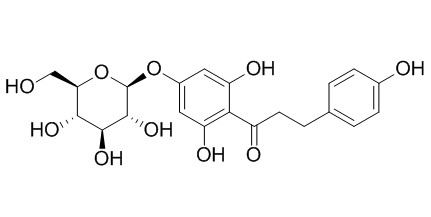Trilobatin
Trilobatin has anti-oxidant, and anti-inflammatory effects, it
can increase superoxide dismutase (SOD) activity, and it potentially inhibits the lipopolysaccharide (LPS)-induced inflammatory response by suppressing the NF-κB signaling pathway. Trilobatin shows a strong inhibitory activity against α-glucosidase and a moderate inhibitory activity against α-amylase for management of postprandial hyperglycemia with less side effect.
Inquire / Order:
manager@chemfaces.com
Technical Inquiries:
service@chemfaces.com
Tel:
+86-27-84237783
Fax:
+86-27-84254680
Address:
1 Building, No. 83, CheCheng Rd., Wuhan Economic and Technological Development Zone, Wuhan, Hubei 430056, PRC
Providing storage is as stated on the product vial and the vial is kept tightly sealed, the product can be stored for up to
24 months(2-8C).
Wherever possible, you should prepare and use solutions on the same day. However, if you need to make up stock solutions in advance, we recommend that you store the solution as aliquots in tightly sealed vials at -20C. Generally, these will be useable for up to two weeks. Before use, and prior to opening the vial we recommend that you allow your product to equilibrate to room temperature for at least 1 hour.
Need more advice on solubility, usage and handling? Please email to: service@chemfaces.com
The packaging of the product may have turned upside down during transportation, resulting in the natural compounds adhering to the neck or cap of the vial. take the vial out of its packaging and gently shake to let the compounds fall to the bottom of the vial. for liquid products, centrifuge at 200-500 RPM to gather the liquid at the bottom of the vial. try to avoid loss or contamination during handling.
Horticulturae2024, 10(4), 382.
Genes (Basel).2021, 12(7):1024.
Front Pharmacol. 2024, 15:1527494.
Nutrients.2020, 12(5):1242.
VNU J Sci: Med. Pharm. Sci.2024, 40(2):21-30.
Applied Biological Chemistry2022, 65(12)
Phytomedicine.2024, 122:155065.
Biomedicines.2024, 12(3):495.
Mol Nutr Food Res.2024, 68(20):e2400414.
J Pharm Biomed Anal.2022, 207:114398.
Related and Featured Products
Food Chem. 2015 Jan 1;166:609-15.
Trilobatin attenuates the LPS-mediated inflammatory response by suppressing the NF-κB signaling pathway.[Pubmed:
25053100 ]
We investigated the anti-inflammatory effect of Trilobatin, the flavonoid isolated from the leaves of Lithocarpus polystachyus Rehd, as well as the underlying molecular mechanisms.
METHODS AND RESULTS:
Treatment with Trilobatin (0.005-5 μM) dose-dependently inhibited the lipopolysaccharide (LPS)-induced mRNA expression and secretion of pro-inflammatory cytokines, including tumor necrosis factor α (TNFα), interleukin-1β (IL-1β) and interleukin-6 (IL-6), in RAW 264.7 macrophages. However, no further inhibition was detected when the concentration of Trilobatin was increased to 50 μM. Western blot analysis confirmed that the mechanism of the anti-inflammatory effect was correlated with the inhibition of LPS-induced inhibitor of nuclear factor-kappa B α (IκBα) degradation and nuclear factor-kappa B (NF-κB) p65 phosphorylation. In addition, Trilobatin also showed a significant inhibition of LPS-induced TNFα and IL-6 at both the mRNA and protein levels in a mouse model.
CONCLUSIONS:
Our results suggest that Trilobatin potentially inhibits the LPS-induced inflammatory response by suppressing the NF-κB signaling pathway.
Z Naturforsch C. 2004 Jul-Aug;59(7-8):481-4.
Antioxidant activities of three dihydrochalcone glucosides from leaves of Lithocarpus pachyphyllus.[Pubmed:
15813365]
In vitro antioxidant activities of three sweet dihydrochalcone glucosides from the leaves of Lithocarpus pachyphyllus (Kurz) Rehd. (Fagaceae), Trilobatin 2"-acetate (1), phloridzin (2) and Trilobatin (3), were investigated.
METHODS AND RESULTS:
The IC50 (50% inhibitory concentration) values for compounds 1-3 of lipid peroxidation in rat liver homogenate were 261, 28, 88 microM, respectively. Compounds 1-3 increased superoxide dismutase (SOD) activity with EC50 (50% effective concentration) values of 575, 167, 128 microM, and glutathione peroxidase (GSH-Px) activity with EC50 values of 717, 347, 129 microM, respectively, and showed only weak DPPH (1,1-diphenyl-2-picrylhydrazyl) radical scavenging activity.
Food Chemistry, 2012, 130(2):261-266.
Inhibitory potential of trilobatin from Lithocarpus polystachyus Rehd against α-glucosidase and α-amylase linked to type 2 diabetes.[Reference:
WebLink]
The chemical structure of the sweet compound from Lithocarpus polystachyus Rehd was identified as Trilobatin on the basis of HPLC, EIS-MS and NMR analyses.
METHODS AND RESULTS:
The inhibitory activities of Trilobatin against α-glucosidase and α-amylase were evaluated, and the inhibition mechanism was analysed with Lineweaver–Burk plots. Also the antioxidant activity evaluation of Trilobatin was conducted by DPPH radical scavenging assay. Comparing with acarbose, Trilobatin showed a strong inhibitory activity against α-glucosidase and a moderate inhibitory activity against α-amylase. The Lineweaver–Burk plots analysis elucidated that Trilobatin inhibited the enzyme non-competitively. DPPH scavenging activity of Trilobatin (IC 50 02=020.5702mg/ml) was higher than rutin (IC 50 02=020.7202mg/ml), which indicated that Trilobatin had a moderate antioxidant potential.
CONCLUSIONS:
These results suggest that Trilobatin is a potential effective α-glucosidase inhibitor for management of postprandial hyperglycemia with less side effect, and provide strong rationale for further animal and clinical studies.



